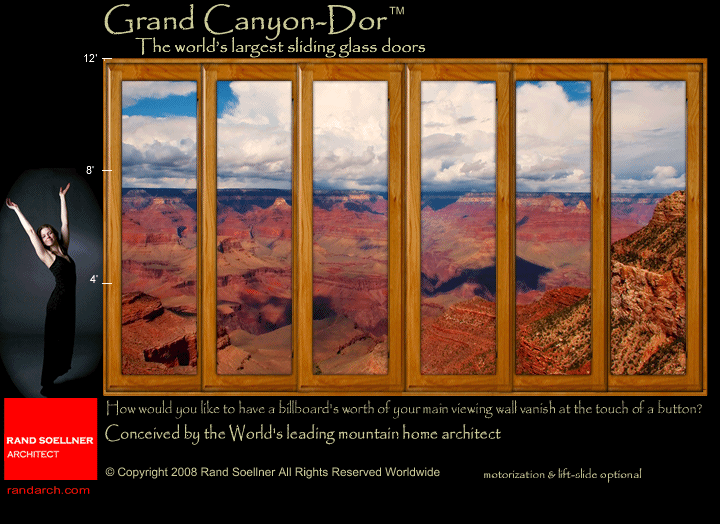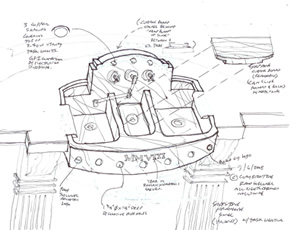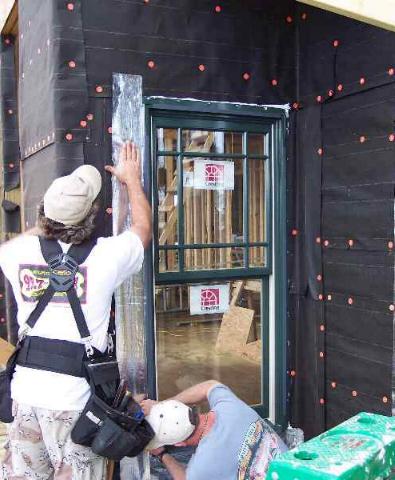Architectural Research Center for Homes International:
established to create a place to investigate the latest developments in home design.
The purpose of ARCH/i (Architectural Research Center for Homes / international):
Better Residential Design by Home Architects
The purpose is to gather data, create and test design features, arrangements and components to improve the architectural design of homes, particularly as created by licensed architects for the public.
 The founder of the Architectural Research Center for Homes / international (ARCH/i) is Rand Soellner Architect. In an effort to constantly improve its home designs, the firm has taken this step to elevate the quality of residential architecture in the world.
The founder of the Architectural Research Center for Homes / international (ARCH/i) is Rand Soellner Architect. In an effort to constantly improve its home designs, the firm has taken this step to elevate the quality of residential architecture in the world.
 “The design of homes is the most personal and constant companion of all of us on this planet, as we all live somewhere. Therefore, we endeavor to improve the quality of this special, sacred, joyous place, to align it with the lifestyles of the people inhabiting them and organized to appreciate the beauty of nature around each home.”
“The design of homes is the most personal and constant companion of all of us on this planet, as we all live somewhere. Therefore, we endeavor to improve the quality of this special, sacred, joyous place, to align it with the lifestyles of the people inhabiting them and organized to appreciate the beauty of nature around each home.”
——- Rand Soellner, AIA / NCARB
Architectural Research Center for Homes / international Reinvests in Company
& Home Design Research
Every year, Rand Soellner Architect, founder of Architectural Research center for Homes / international and one of the leading timber frame architects, invests approximately 18% of income and resources back into the company for research and development of home design, to continually improve what we do. This includes upgrades and maintenance of equipment, improvement in methods of residential design and production and improvements in the home designs themselves. This dedication to excellence and improving the art and science of architectural home design is why we are a leader in what we do. We actually enjoy what we do, that’s one of the reasons we continue to invest in it. We get satisfaction and enjoyment from seeing, each year, how we are now doing things better, delivering higher quality design, documents and technology to you for your project dreams. This ARCH/i (Architectural Research Center for Homes) page is just one of the ways we try to bring this message to you, our clients.
Custom Home Architects Upgrade Printing Technology for Higher Quality Documents
Recognizing that old-fashioned blueprints are not only time-consuming, not very enjoyable to run and especially: not very clear, Rand Soellner Architect recently purchased a brand new wide-format printer type from Hewlett-Packard, the HP Z2100, which is a photo-quality full-color printer. Soellner now prints on white bond paper in color, which has remarkable clarity and sharpness. No more fuzzy blueprints. The new printer has pigmented inks that have been tested by HP to be archival for up to 200 years and are also water-resistant, so that contractors can use Rand Soellner’s new color prints in the field to build Rand Soellner Architect projects, with better durability than blueprints. Clients of Rand Soellner’s also will enjoy cleaner, clearer prints on white paper, with color accents. This is just one more commitment to quality from Rand Soellner home architects for better documents.
Luxury Residential Architects Base Bid Pricing Strategy
Here’s a circumstance that most builders and homeowners (who have had custom homes designed) have experienced:
You have paid a lot to have someone design a nice house for you. The design included absolutely everything you asked them to include. You may have mentioned that you would like for the residence to cost a certain amount of money. Unfortunately, you do not yet have pricing done by the builder, so you are not sure, but you are confident and you proceed. Now, after months of careful preparation, here comes the contractor with his estimate. Holy Toledo! You didn’t know the construcion cost would be that much! How could this have happened? You said you wanted it to only cost so much. Surely everyone should have included everything you wanted in that price! Outrageous. Then you leave in a huff and ponder what to do.
Sound familiar? We used to see this happen all the time. Contractors still do. It’s called the “Come to Jesus” meeting, when the builder finally knows how much it will cost to build the wonderful project you want. After all, it will cost a million dollars! Surely that will include whatever you want, know matter what that is!
Well, that is not the way contractors work. Costs are costs. Period. Nothing is included with anything else. You pay for what you get. If you want to spend a million dollars, then you reduce the square footage, or reduce the quality of the materials, or delete some features, or all of these from your documents. Also, most designers and architects are not really great at cost estimating and you probably haven’t paid them to produce an estimate, have you? You expect them to simply know. Well, they don’t. They are there to include what you request and they want to say yes to you. Prices to build homes are fluctuating wildly both in time and in geographic region and with respect to the amount of detail, especially in these interesting economic times.
So, is the situation hopeless for your project? Are you condemned to live out this sorry scenario time after time, getting more agitated with each disappointment?
No, you are not. That is why we have invented what we call our Base Bid Pricing Strategy. What is it? How does it work? How does it avoid the “Come to Jesus” session?
1. Base Bid Pricing / Home Value Engineering :
The Architectural Research Center for Homes has evolved a means of creating Construction Documents (know as CDs in the industry) that include the most economical methods of building the project (and still have it look similar to what we are illustrating in our documents). For instance, we indicate usage of painted drywall in the majority of the project as part of the Base Bid Price, which is one of the least expensive ways to build a house (look at tract housing in your community; that’s what they are using). There are hundreds if not thousands of these Base Bid Pricing items throughout our CDs, which means that if your builder adheres to the pricing presentation we have instructed in our specifications, the Base Bid Price will be the most economical means of building your project and still be occupiable, functional and still receive a Certificate of Occupancy from your County or City.
2. Owner Optional Upgrades for your House:
These are all those “goodies” that you have told us you want, and other upgrade items that many of our clients seem to appreciate, that we include in the CDs, labeled as “Owner Optional Upgrades” for your house. There are typically hundreds of these throughout the CDs, clearly labeled. Once your builder prices the Base Bid for your project for Item 1. above, our instructions to him are that he is to then ask you which of the Owner Optional Upgrades you want him to price for you. So, after you see how much money you are going to spend on the basic home project, and you have an idea of how much more you might wish to spend on upgrades, you identify those options to the builder. You are not alone. We will join you in this session if you wish, but even before this, we have built into our CDs numerous “Architect’s Suggestion” beside those options in the documents we would select if it was our project. In this fashion, you will have our guidance every step of the way on your documents. Your Contractor then notes your requested options on his set of CDs (that we have prepared for him and you). He goes away and prices all of the options you have requested. You meet again. The builder then presents a spreadsheet will all of your options like an ala carte menu, each with a price. Then, you prioritize the options most dear to you, adding them together, until you reach the price with which you are comfortable. Then, the Contractor prepares the agreement between you and him for the price agreed upon for the exact scope of work described in the house design documents. This process will need to vary somewhat for accelerated cost-plus types of agreements. This is part of the Home Value Engineering methodology.
Okay, so what is so significant about this process for residential designs? What makes it so valuable to you? Well, for one thing, do you notice that YOU are the one who has determined how much your project is costing, not your architect or builder. You. Also, do you notice something missing in our Base Bid Pricing Strategy for your house design? No Come to Jesus session. You already received the least expensive Base Bid Price , and you know that is the least expensive way to construct your project. Then, you decided what upgrades to include.
Why doesn’t anyone else do it this way? Why does the Architectural Research Center for Homes do it this way? Well, it is a lot more work to prepare the architectural documents for home designs in this manner. It is also more work for your builder to price the documents. So what? It puts you in charge of what you get for what you want to spend for your new home. It also takes out the guesswork of your construction costs. You are getting actual pricing proposals from your builder based on your house design, not estimates from people who don’t build things. Is this easy to do? No. We invented it for residential documents. It is very detailed and takes a great deal of focus to clarify what is Base Bid and what is Owner Optional in the CDs. Home Value Engineering Architects take this approach to control your budget. We have this throughout our floor plans, elevations, building sections, details, door schedule, finish schedule and specifications. That’s a lot of coordination to do. Most companies just can’t take the time to devote this much energy to this aspect of a residential design, for which they perceive they are not being paid to do for you. We do it as a matter of course on all our projects; it has become our Standard Operating Procedure. Work for us; better pricing control for you Rand Soellner home architects puts you in the drivers seat regarding what you spend for your construction costs. Now that you understand this, why would you want to have your residential project designed any other way? Call Rand Soellner at 828-269-9046.
Here are just some of the Research/Topics of interest of the Architectural Research Center for Homes :
RAND SOELLNER ARCHITECT RESEARCH AND DEVELOPMENT TO MAKE SCREENING LESS VISIBLE FOR HOME DESIGNS:
* “HD” WINDOW SCREENS:
It has long been a desire of ours that we could make insect screens invisible or do away with them. It is not practical to not have screens at operable windows and doors, but we do have some techniques to make them seem to go away. There are some excellent options to render them nearly invisible, or at least less noticeable. While recently touring the Marvin Window factory in Warroad, Minnesota, Rand and Merry Soellner noticed a special type of new wire window screen that Marvin calls: “High Transparency.” It is made of metal wire that is thinner than normal insect screen, making them less noticeable, hence the term: “High Transparency.” All of our new window screens will be specified as such. The result should be closer to our ultimate goal of as little between you and your views as possible.
* PHANTOM SCREENS:
This is a company that makes a vertical canister on each side (or one side) of your operable doors and windows and into which the screen rolls. This means, when you have the window closed, you keep the screen rolled into the jamb canister. When you open the window, that is when you pull out the screening to cover the window opening. I asked our tour guide, Tim, at Marvin if they are developing anything like this and he said yes. We also recently learned of Jeld Wen offering a vertical Phantom Screen roll-up option into a header valance trim piece and this integral approach sounds like an excellent idea. You can treat your screens like roll-up blinds, where they are invisible until you open your window and then deploy them.
* SCREENING OF OUTDOOR LIVING ROOMS:
What makes our Grand Canyon-Dor TM so practical is the fact that when you open the billboard’s worth of wall by retracting the enormous glass doors, the outdoor living room onto which they open is totally screened, keeping out insects. This also means that when the large doors are closed, the screens are about 20’ away from them, around the perimeter of the Outdoor Living Room, making them nearly invisible from the interior of the home.
* What is the best window/wall view aperture?
This relates to the best height and width of views in mountain homes to allow people to appreciate the wonderful views they have. This guides us as architects in designing the best height and width of windows and window treatments to facilitate the degree of openness desired for the main views. Most mountain houses unfortunately have head heights that are much too low and this results in blocking of the view, in many cases right at the intersection of the sky and mountain ridge lines you want to see out of your home. Widths are also often much too narrow, with your walls, fireplaces and other elements blocking the views you have paid so dearly to appreciate. How do we judge what is best? Rand Soellner’s major at the Universityof Florida was always Architecture and he also had a minor in Environmental Psychology, a set of courses custom arranged between the U of F Psychology Department and the College of Architecture and Fine Arts, to facilitate Mr. Soellner’s research in how spaces affect human perception. Much of the data was obtained from NASA, Social Psychology data, University of Utah’s Environmental Psychology research and Mr. Soellner’s own tests. The relationship of the proper mountain view window aperture also relates to human physiology and the distribution of rods and cones in our eyes and the fovea (a concentration of receptors in the human eye in which much of our fine detail perception is received). This angle is calculable and relates directly to Rand Soellner Architect’s building sections and floor plans and distance to the items being viewed, to insure that your views are maximized. This is why all Rand Soellner Architect house designs have a Wow Factor; the views are spectacular, because they have been planned to maximize your perception of them.
* What are the best finishes for you? What makes you feel comfortable?
We have learned that different people have different preferences. We conduct question and answer sessions in which we discover your preferences, many of which have ease of maintenance related issues, both inside and outside your residence. Then we provide your preferences.
* What are the best, longest-lasting finishes for your home (inside and outside)?
This relates to special coatings for large timbers and also everyday concerns about tile cleaning, woodwork, appliances and other surfaces.
Mountain Retreat Home Design by Mountain Home Architects
State of the art in mountain home design. It is the cutting edge of mountain home design. We have about 8 homes either beginning construction or under design right now employing the Mountain Retreat home design concepts. They all exemplify the organization, features, appliances, energy efficient home design, aesthetics, materials and other aspects that our clients have been requesting during the last several years, all rolled into each design: the best of the best. For obvious trade secret reasons, we do not publish our plans and have been so busy developing this latest series that we have not made the time to produce marketing images of them. Every client who has visited us and seen this series during the last 30 months has said: “I want that!” when we displayed our Mountain Retreat series concepts to them in person. Come and visit us. Here, you will see what we are talking about:
* Open plan home arrangements combining the main living spaces .
* Outdoor living rooms, summer kitchens, outdoor dining rooms.
* Sleeping porches with all of the latest amenities, including hot tubs and fireplaces.
* Our Trademarked “Grand Canyon-Dor TM” enormous doors that become invisible!

* The latest appliances in our home designs.
* Healthy Home Design features so that you can breathe easy.
* Energy Star Architect compliance and beyond, for your comfort and energy efficiency in our houses.
* Our award-winning “Timeless Mountain Architecture” aesthetics for which we have become famous in magazines, newspapers and books about fine mountain architecture.
You can see photos of these concepts as the latest Mountain Retreat home designs in our Mountain Home Retreats section under projects in our menu. Thank you for your interest! Amazing big timber frame trusses! Beautiful big glass areas! Open plan design! Everything you’ve been dreaming of for your house!
On Rocket Science & Reinventing the Wheel by Architectural Research Center for Homes
 Some people say things about: “It ain’t rocket science” and “Don’t reinvent the wheel.” Well, as it turns out, Rand Soellner actually did some design work for NASA involving rockets; he was the project architect and project manager on a project in which he created an optical laboratory where the cameras that track the Space Shuttle are calibrated. It has a clean room, optical grinding equipment, fume hoods and other scientific apparatus related to the space program.
Some people say things about: “It ain’t rocket science” and “Don’t reinvent the wheel.” Well, as it turns out, Rand Soellner actually did some design work for NASA involving rockets; he was the project architect and project manager on a project in which he created an optical laboratory where the cameras that track the Space Shuttle are calibrated. It has a clean room, optical grinding equipment, fume hoods and other scientific apparatus related to the space program.
 With respect to reinventing the wheel; that is how the new run-flat tires were invented, how Harvey Firestone created durable rubber tires instead of the clumsy wooden and metal buckboard wheels in use at that time, and how horse-driven carts and wagons allowed mankind to haul their products, belongings and travel faster and more comfortably than on foot or just on horseback. So, some the best things in our civilization that we all take for granted come from people who do literally reinvent the wheel.
With respect to reinventing the wheel; that is how the new run-flat tires were invented, how Harvey Firestone created durable rubber tires instead of the clumsy wooden and metal buckboard wheels in use at that time, and how horse-driven carts and wagons allowed mankind to haul their products, belongings and travel faster and more comfortably than on foot or just on horseback. So, some the best things in our civilization that we all take for granted come from people who do literally reinvent the wheel.
 What does this have to do with what Rand Soellner home architects does?
What does this have to do with what Rand Soellner home architects does?
We reinvent House Design.
We reinvent the spaces in and outside of the Home.
We reinvent the things in the residence, including, literally, the kitchen sink (yes, we are actually redesigning how a kitchen sink ought to function and look, right now!).
We were recently asked by a manufacturer in America’s Heartland to design a line of products for the home that have our special attention to function, logic, aesthetics, detail, interest. We seek to delight homeowners and the people who honor us by having us design their houses.
And we thank you for the privilege of being of service to you. We truly love what we do and enjoy improving how the American Home is being redefined.
Flashing Improvements for Better-Sealed Window & Door Construction by Architectural Research Center for Homes
Rand Soellner home architects recently underwent an exhaustive analysis of various flashing tapes with manufacturers of these products and came to conclusions to improve the sealing around doors and windows in their house designs. Many builders and other designers are not aware that the flashing tapes on the market are manufactured to adhere to particular substrates, and unfortunately, one tape type and model does not adhere to all surfaces.
 Building Sciences Corporation has some information about this subject and they have found that while the uncured butyl tapes perform well around rough openings and bond well to typical window fins and door frames, they did not address bonding to asphaltic felt. We researched this subject with various manufacturers and learned that modified asphaltic flashing tapes are the only flashing tapes that will adhere to asphaltic felt. We take a 3-step approach to insure proper seals at this often neglected area of water penetration, first sealing the rough opening, then bonding the window nailing fin and door frame to the sheathing, then sealing the wall water resistive barrier membrane to the edge of the window and door frame. It takes different products to handle the various finishes and substrates to create a proper seal at each stage of this application. We have also found that there is considerable controversy in the use of exterior water barriers and we have developed opinions on this matter as well, but that is a subject for another article.
Building Sciences Corporation has some information about this subject and they have found that while the uncured butyl tapes perform well around rough openings and bond well to typical window fins and door frames, they did not address bonding to asphaltic felt. We researched this subject with various manufacturers and learned that modified asphaltic flashing tapes are the only flashing tapes that will adhere to asphaltic felt. We take a 3-step approach to insure proper seals at this often neglected area of water penetration, first sealing the rough opening, then bonding the window nailing fin and door frame to the sheathing, then sealing the wall water resistive barrier membrane to the edge of the window and door frame. It takes different products to handle the various finishes and substrates to create a proper seal at each stage of this application. We have also found that there is considerable controversy in the use of exterior water barriers and we have developed opinions on this matter as well, but that is a subject for another article.
Resources and links:
mountain home architects
log home architects
home architects
